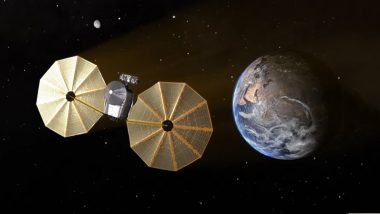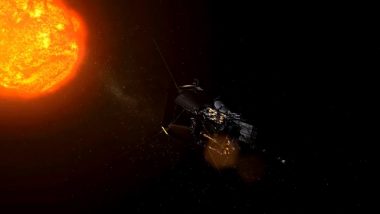Washington: A NASA spacecraft named Lucy, the first mission to the Jupiter Trojan asteroids, will skim the earth's atmosphere, passing a mere 350 kms above the surface on October 16, to gain some of the orbital energy it needs to travel to this never-before-visited population of asteroids. The Trojan asteroids are trapped in orbits around the Sun at the same distance as Jupiter, either far ahead of or behind the giant planet. Pictures of Jupiter: NASA Releases New Stunning Images of Jupiter Captured by James Webb Space Telescope (Watch Video).
Lucy is currently one year into a 12-year voyage and this gravity assist will place it on a new trajectory for a two-year orbit, at which time it will return to Earth for a second gravity assist, NASA said in a statement. This second assist will give Lucy the energy it needs to cross the main asteroid belt, where it will observe asteroid 'Donaldjohanson', and then travel into the leading Trojan asteroid swarm.
There, Lucy will fly past six Trojan asteroids: Eurybates and its satellite Queta, Polymele and its yet unnamed satellite, Leucus, and Orus. Lucy will then return to Earth for a third gravity assist in 2030 to re-target the spacecraft for a rendezvous with the Patroclus-Menoetius binary asteroid pair in the trailing Trojan asteroid swarm, according to the space agency.
Our #LucyMission will fly past the Earth at about 7am ET (1100 UTC) this Sunday, Oct. 16—and it'll be close enough to spot from parts of Australia and the western United States!
If you'll be watching, share your photos with the #WaveToLucy hashtag: https://t.co/fgu8yfgAbZ pic.twitter.com/1iwhgEupOJ
— NASA (@NASA) October 13, 2022
Lucy's trajectory will bring the spacecraft very close to Earth, lower even than the International Space Station, which means that Lucy will pass through a region full of earth-orbiting satellites and debris. To ensure the safety of the spacecraft, NASA developed procedures to anticipate any potential hazard and, if needed, to execute a small manoeuvre to avoid a collision.
"The Lucy team has prepared two different manoeuvres. If the team detects that Lucy is at risk of colliding with a satellite or piece of debris, then, 12 hours before the closest approach to Earth, the spacecraft will execute one of these, altering the time of closest approach by either two or four seconds," said Coralie Adam, Lucy deputy navigation team chief from KinetX Aerospace in Simi Valley, California. This is a small correction, but it is enough to avoid a potentially catastrophic collision, Adam added.
"In the original plan, Lucy was actually going to pass about 30 miles closer to the Earth," said Rich Burns, Lucy project manager at NASA's Goddard Space Flight Center in Greenbelt, Maryland.
Lucy will be passing the Earth at such a low altitude that the team had to include the effect of atmospheric drag when designing this flyby. Lucy will then rapidly recede from the Earth's vicinity, passing by the Moon and taking a few more calibration images before continuing out into interplanetary space.
(The above story first appeared on LatestLY on Oct 14, 2022 01:43 PM IST. For more news and updates on politics, world, sports, entertainment and lifestyle, log on to our website latestly.com).













 Quickly
Quickly





















